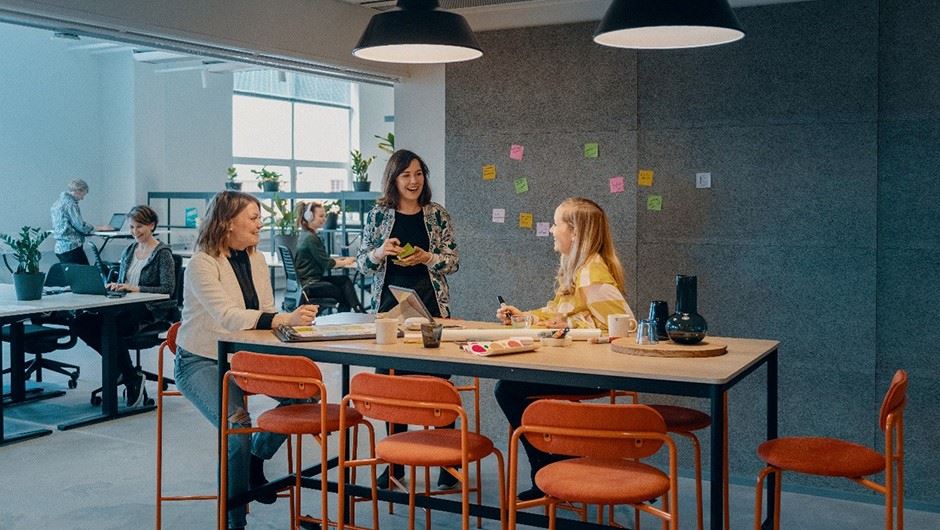Sustainable data centers as a service
- Traffic
- Work
- Construction
- Retail
- 10/5/2021
Finding the right direction for business development by co-creating with stakeholders
Service design is a human-centered and participatory approach to problem-solving that provides in-depth understanding of the stakeholders in a project and the desirability, feasibility and viability of a business idea. By actively involving and systematically collecting data about the end users, customers, experts and other parties, the chances of succeeding with a development project can be strengthened and risks minimized.

“Construction projects are often developed to an advanced phase before a wider group of stakeholders is involved or has the opportunity to give feedback. This leads to collisions that delay project schedules and cost money. Involving the various stakeholders as early as possible helps create solutions that are not only technically feasible and financially viable but answer to customer needs and thus, bring in more profits in the end,” says YIT’s Lead Service Designer Ninja Fedy.
The key in human-centered development is to involve stakeholders in the development process. Service design is based on a logical process where it is important to first research the topic by collecting various types of data to make sure that right user problems are being addressed. With the help of qualitative and quantitative insights, an overview about the topic can be created to bring out connections between different matters of relevance. First after the research findings are synthesized with the project group the problem-solving phase can be started.
To increase the chances of creating desirable services and projects, ideas are created in multifunctional teams and solutions are designed together and tested with a wide variety of stakeholders. This agile and human-centered way of developing solutions provides evidence for decision-making and helps to allocate resources into right aspects before much time and money is spent on the implementation of a solution.
”I currently work a lot with companies that are thinking about the future of business premises and looking for answers to the question of what people expect from office facilities in the future. Looking at people’s behavior in more detail and knowing how feel about the future helps to develop more sustainable solutions and more accurately assess future needs for space,” says Ninja Fedy.
In addition to creating new services and products, service design methods can be used to improve existing solutions, processes and employee experience or even in to create strategies together with stakeholders.
Service design methods can be used to correct the course in an agile way
People have many behavioural biases that affect decision-making, which affect and cause challenges in business development. The longer one proceeds with the development of a specific solution, the more difficult it is to accept feedback that differs from one’s own or the core group’s views. Therefore, it is a good idea to have feedback from stakeholders regularly throughout the project. Service design is at its best here, because it allows correcting the course in an agile manner and introduces the project with a broader insight from outside of construction and traditional project planning.
Especially in the service business, customers have high, constantly changing expectations Therefore, it is important to make sure that feedback is listened to with a keen ear even after the launch of a new service and that there are enough resources to continue iterating the service. After all, the world is changing fast and services need to adapt to these changes to continue being competitive in the marketplace.
Cost-effective data and committed stakeholders
Most of the service design methods and tools are easily approachable and can be used by anyone with the help of experienced service designers. Refining quantitative information with qualitative data is important in addition to numerical data, as it allows increasing understanding of why something happens.
Often, simply having quick interviews with end-users and customers provides answers to what the underlying root causes are and what user needs a business solution should address. Another effective qualitative data collection method is to observe people in service situations or in a certain space in order to see how people behave in real-life.
Different types of intensive service design workshops are an effective way of synthesizing information, concretizing and testing business ideas and getting important stakeholders committed to the project.
”You do not need to know everything yourself. On the contrary: co-creating with stakeholders and collecting various types of data facilitates decision-making and provides proof for arguments supporting different solutions. In fact, I often use direct experts from people as part of my concept proposals, as they often reflect the end users’ genuine needs and expectations. Therefore, I encourage all business developers to speak to end users, curiously observe different service situations, co-create solutions with stakeholders and make the resulting findings part of decision-making, such as investment proposals,” says Lead Service Designer Ninja Fedy.




